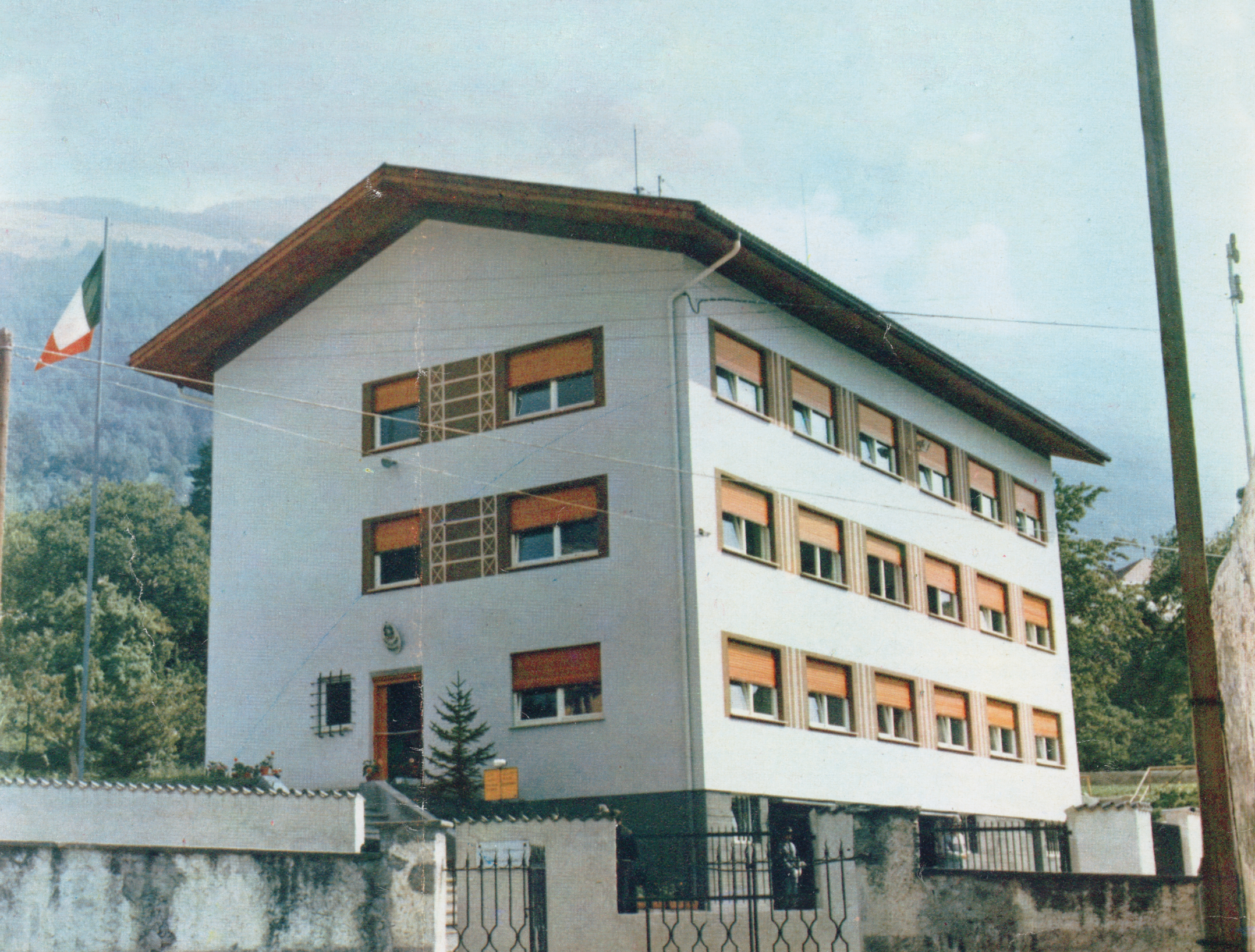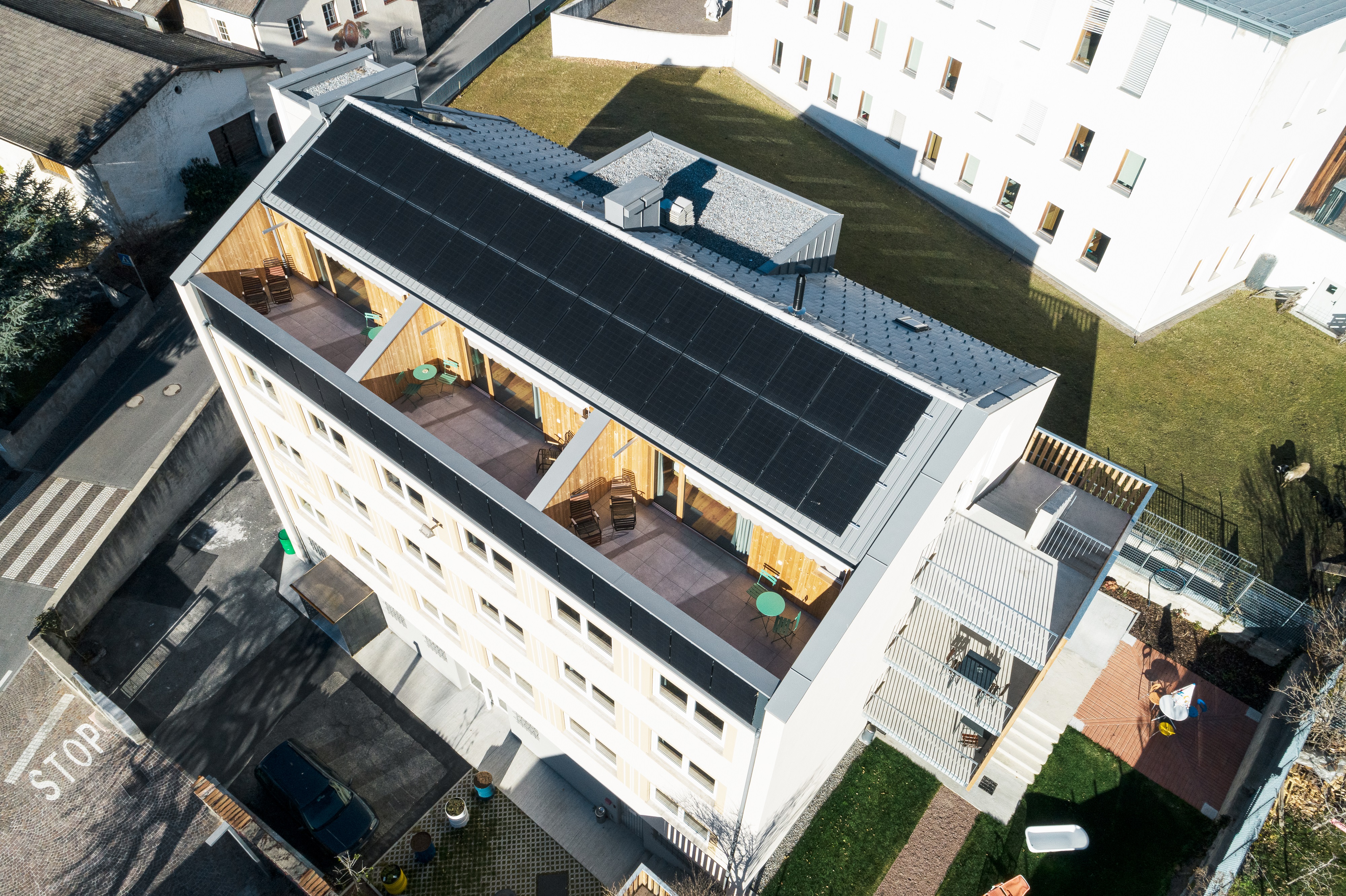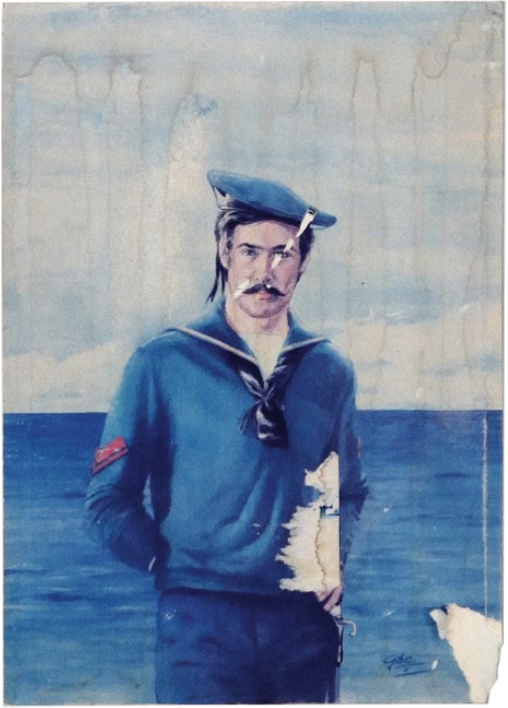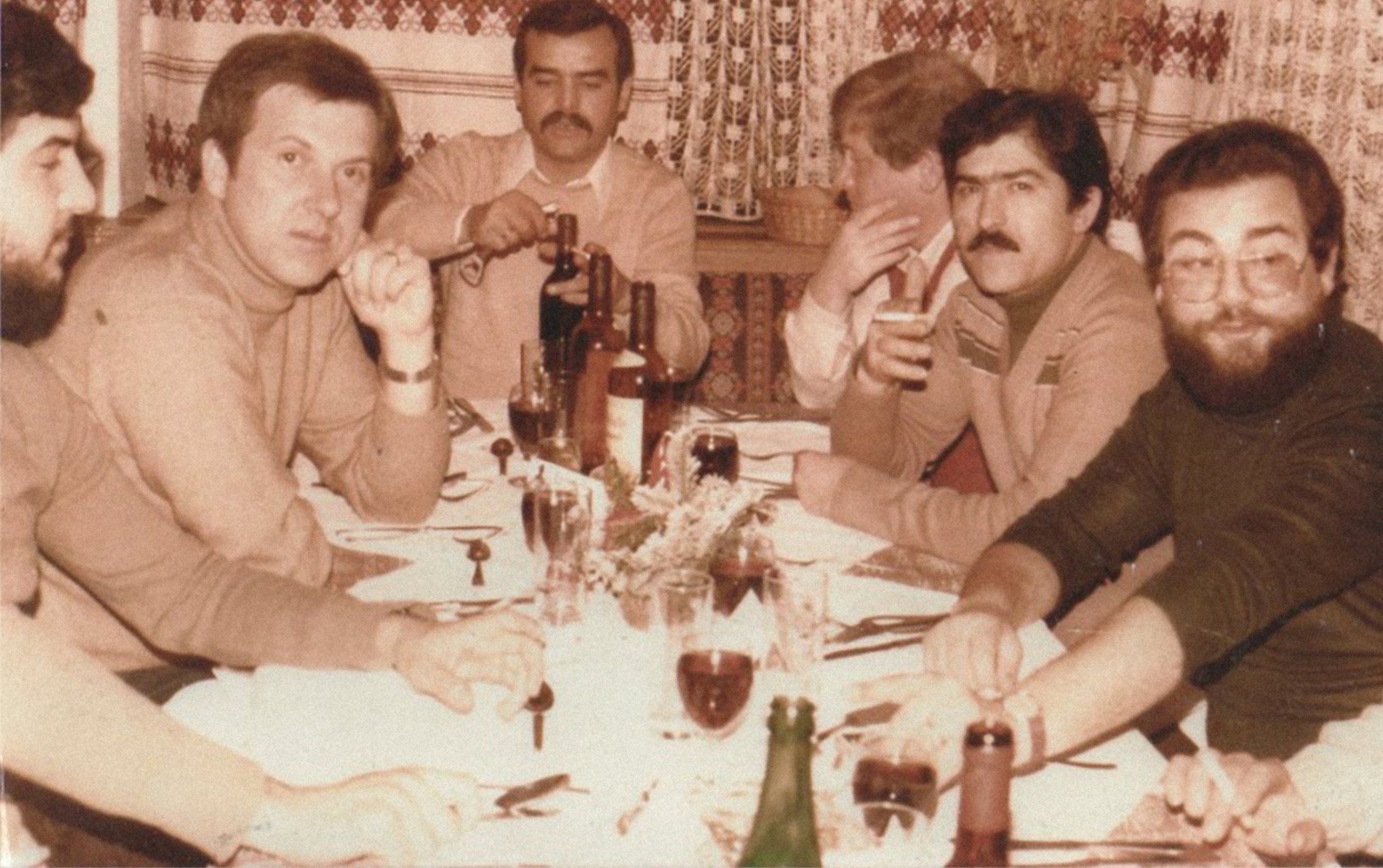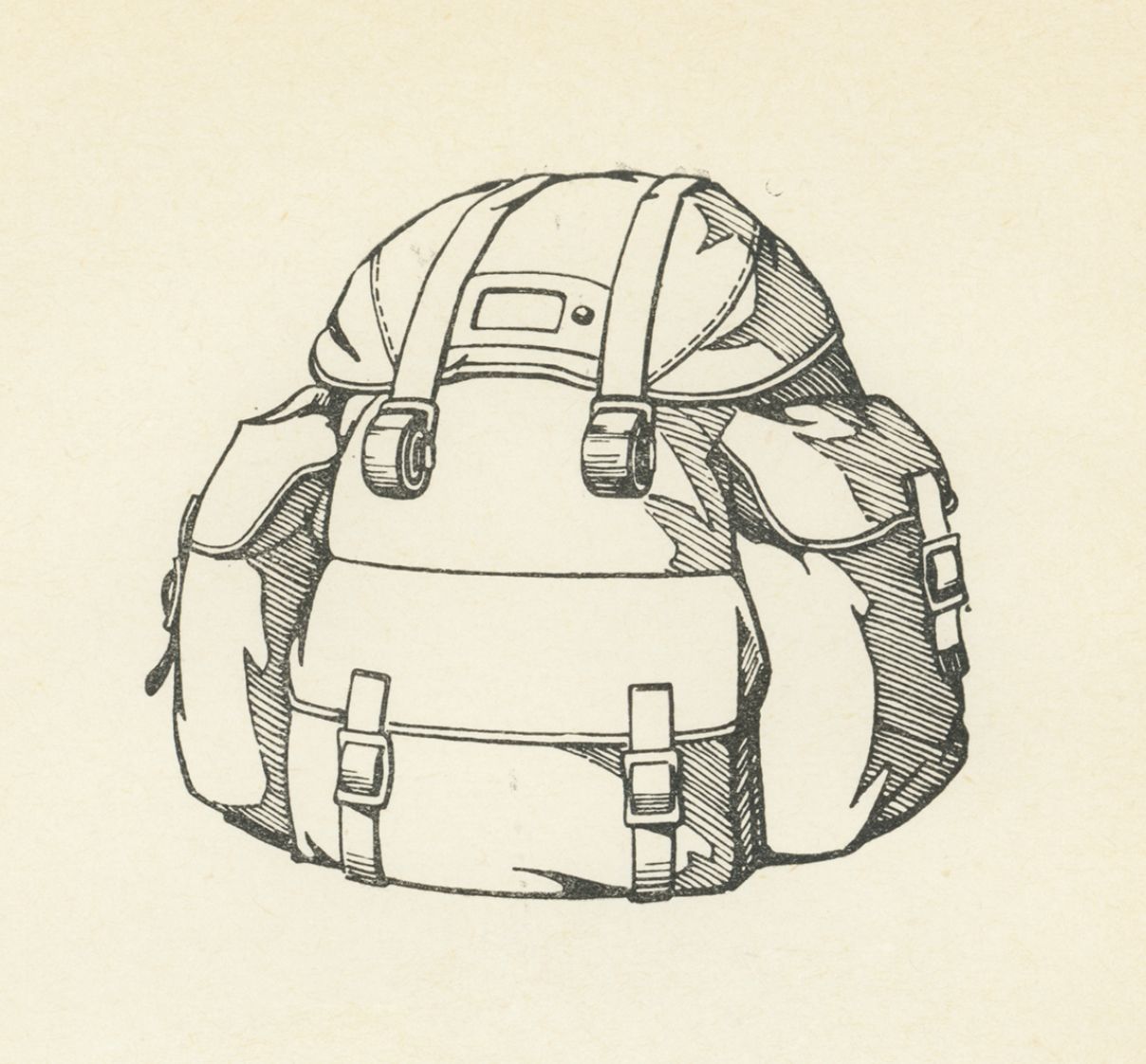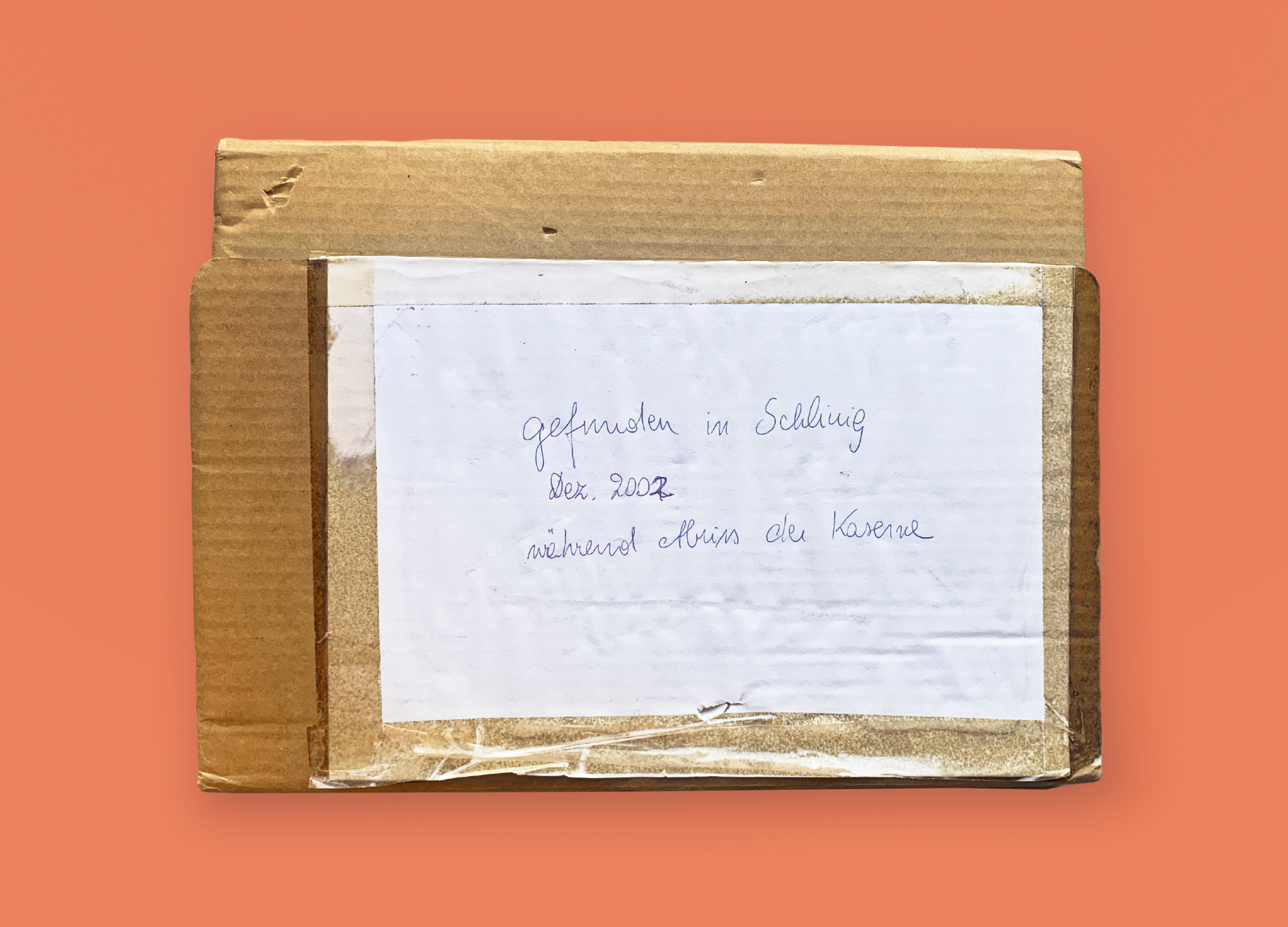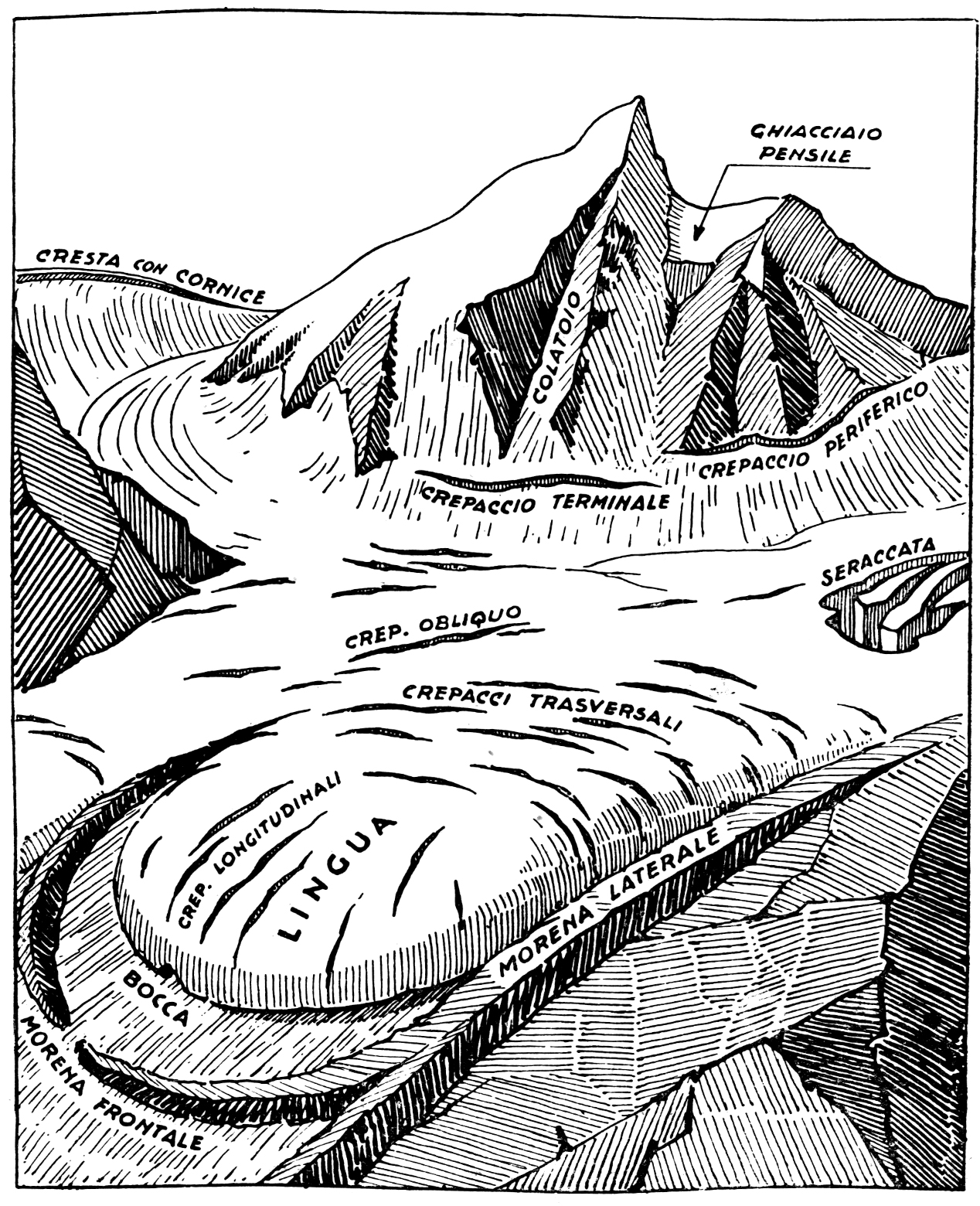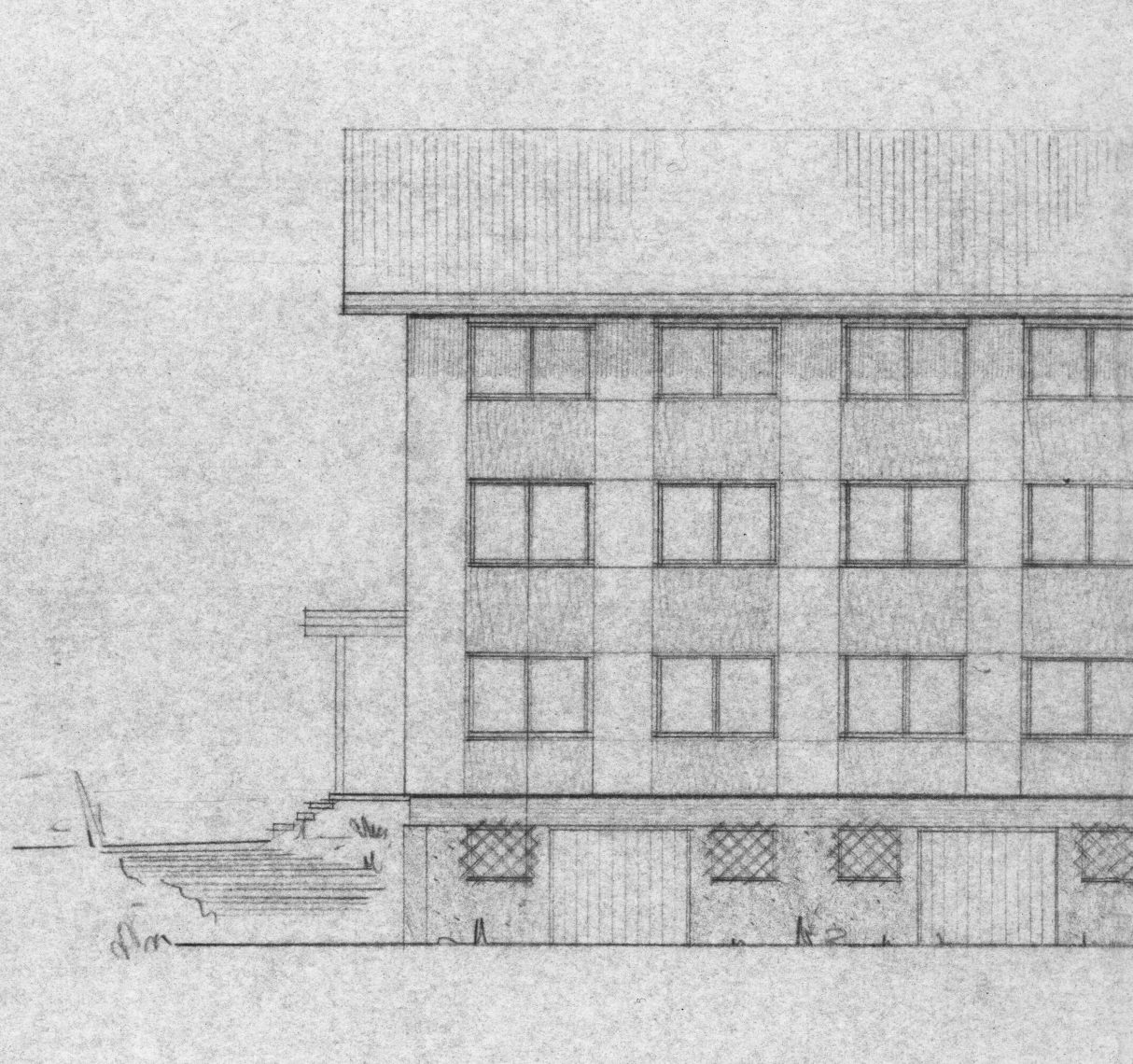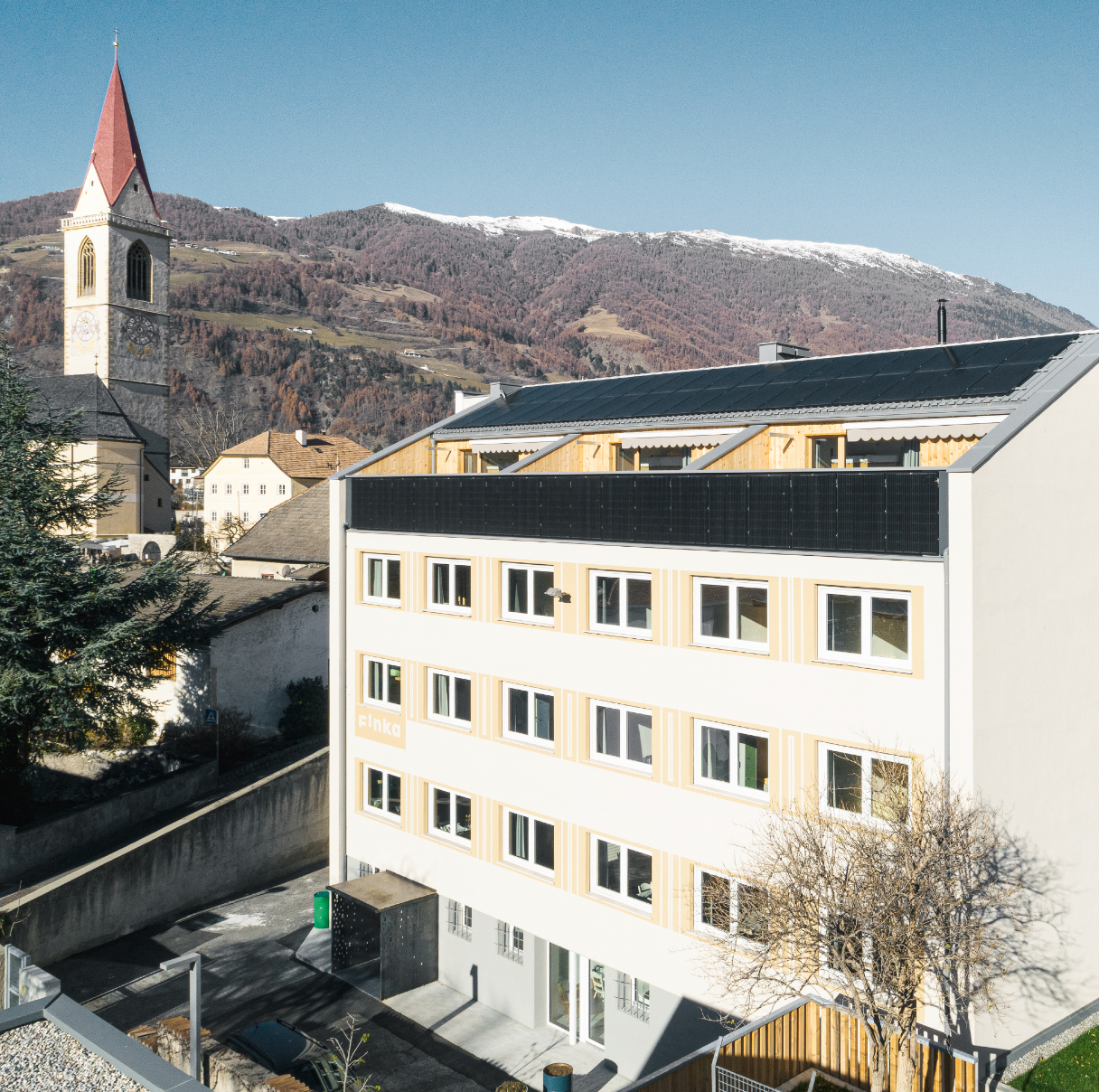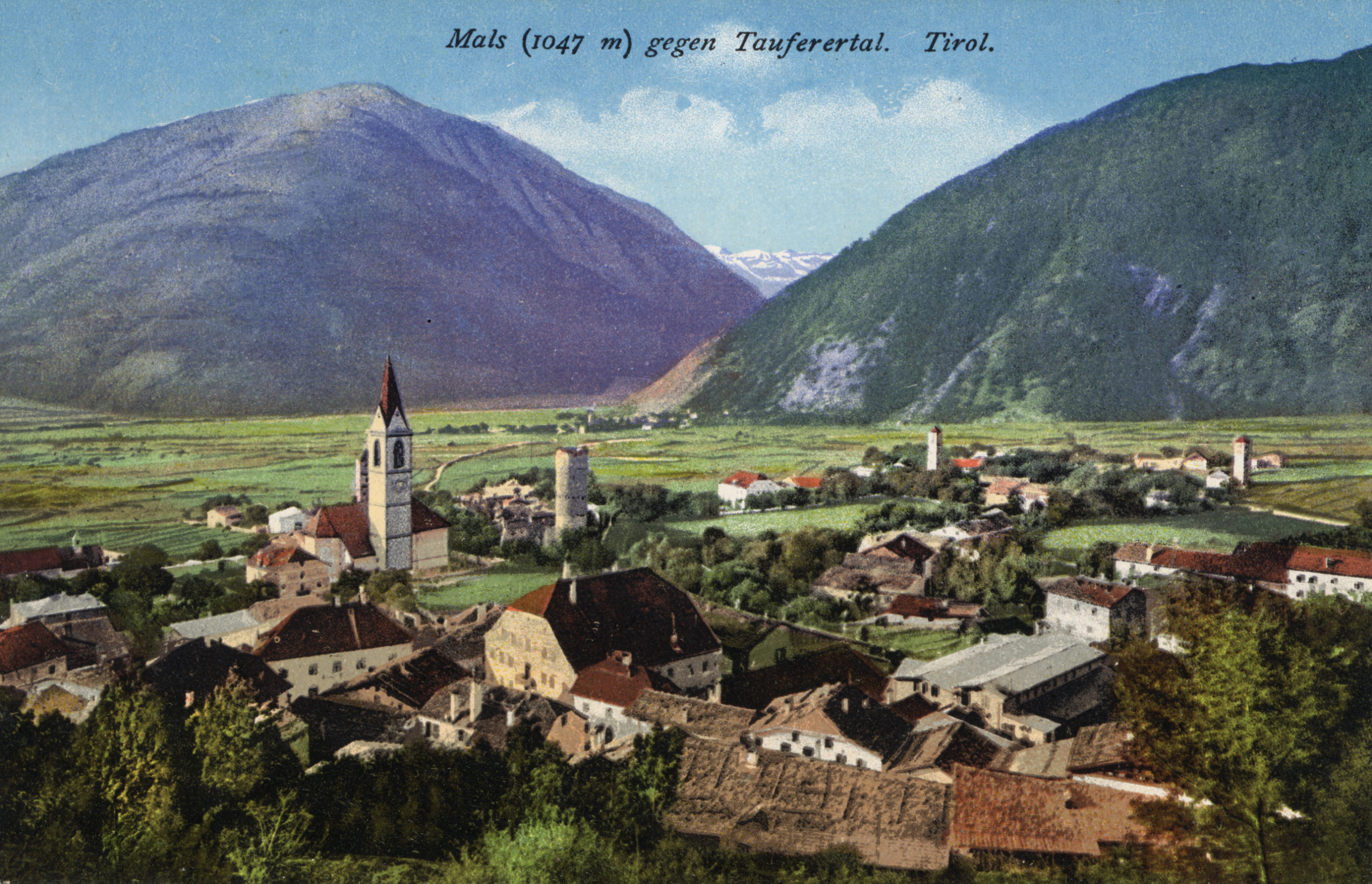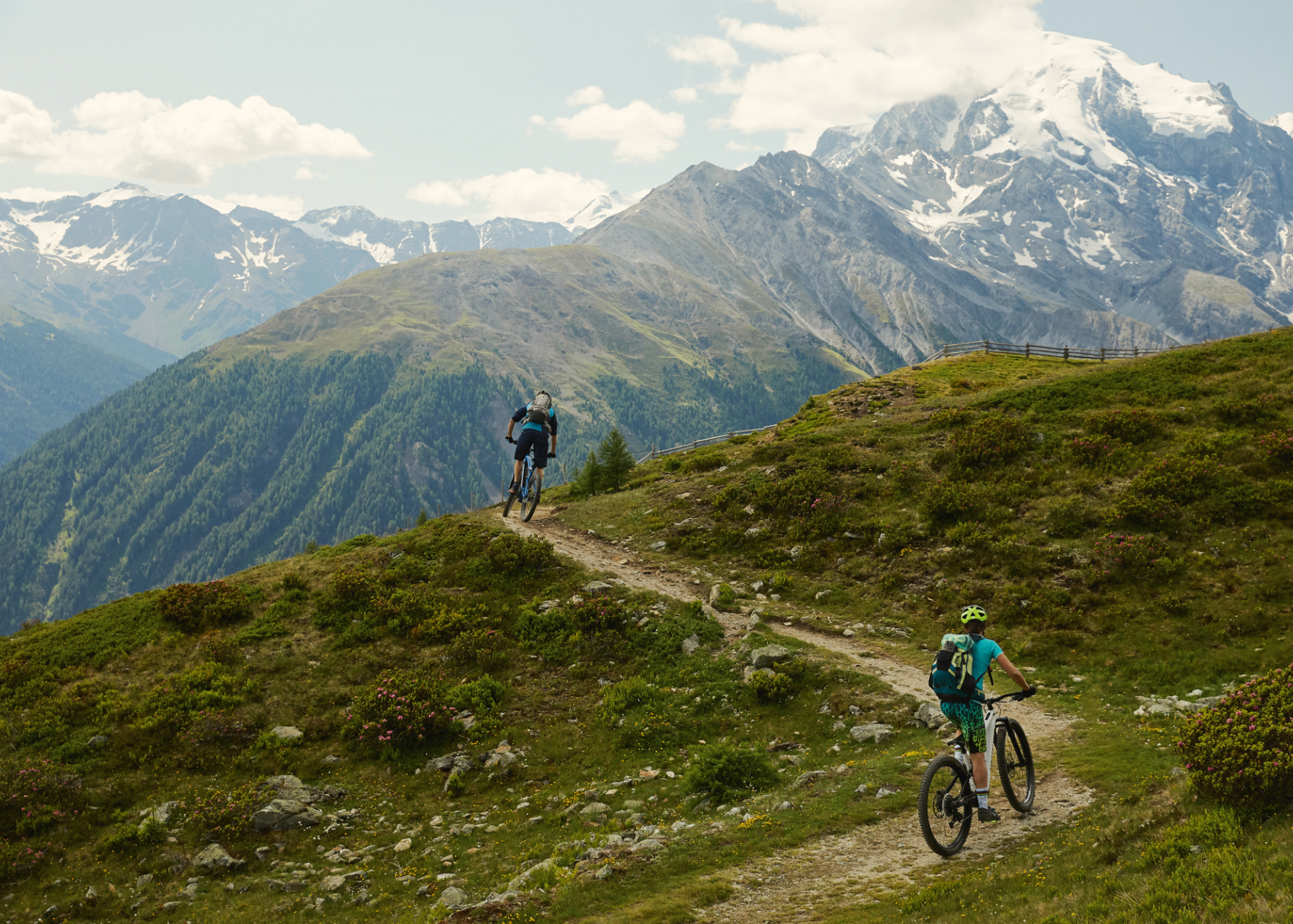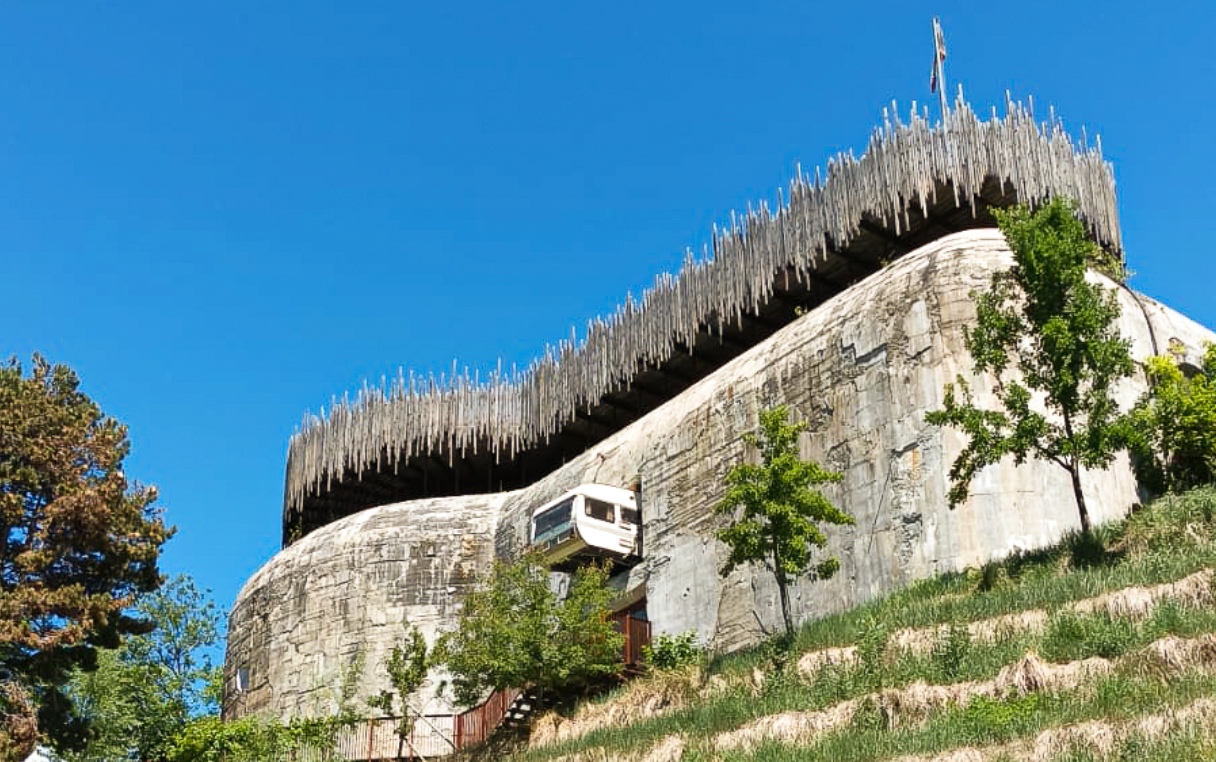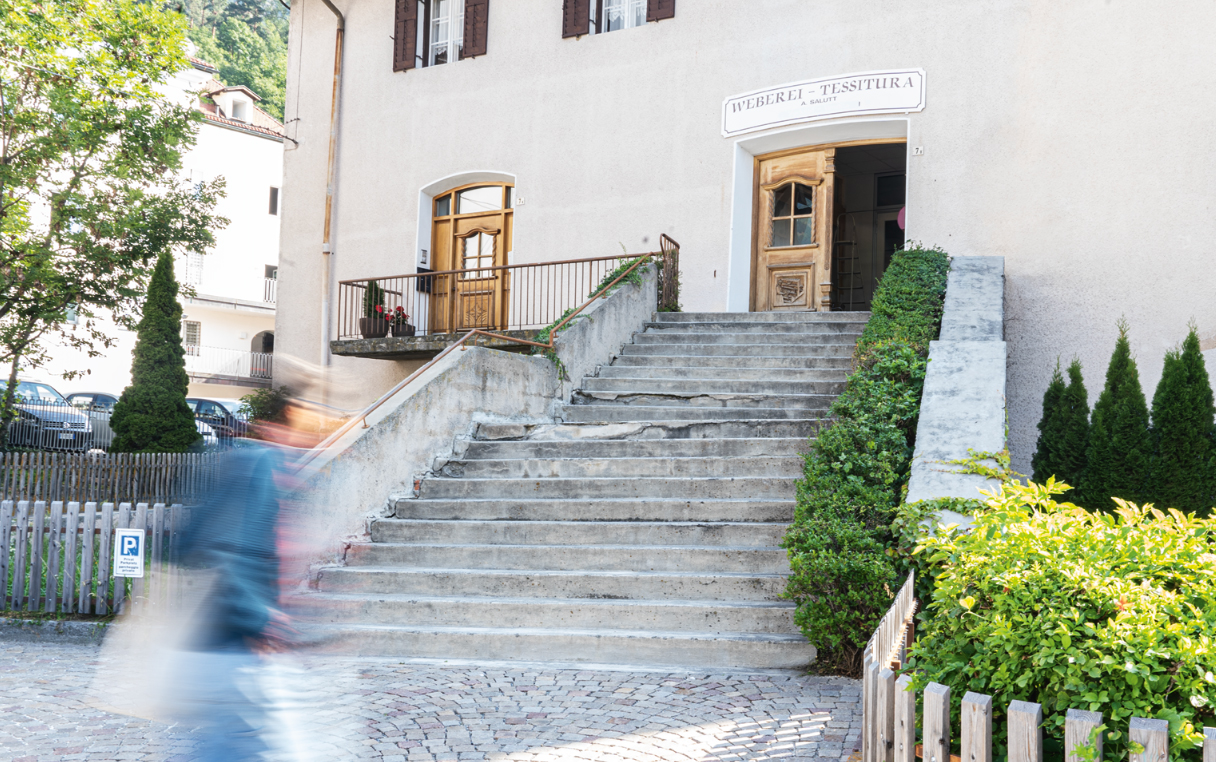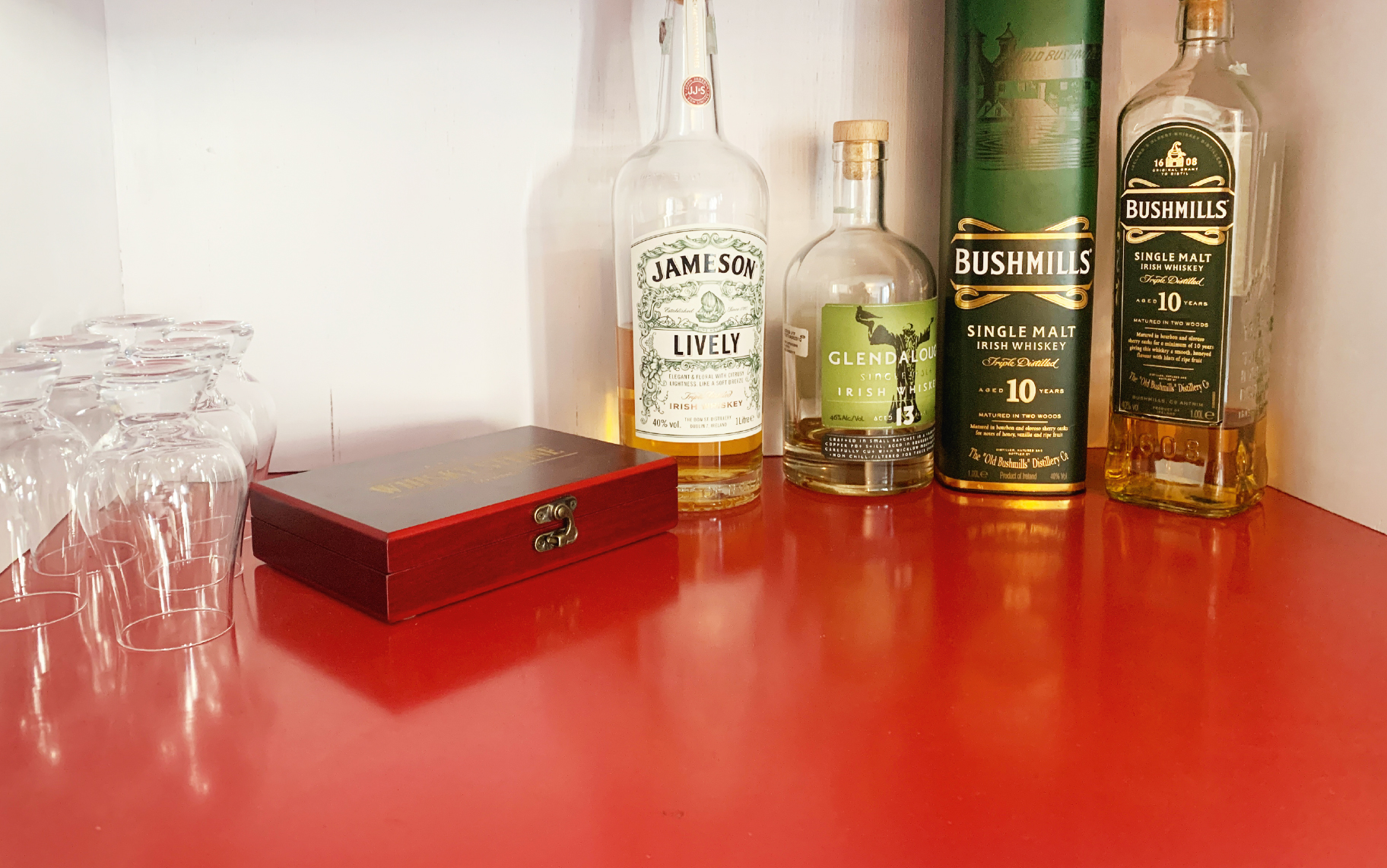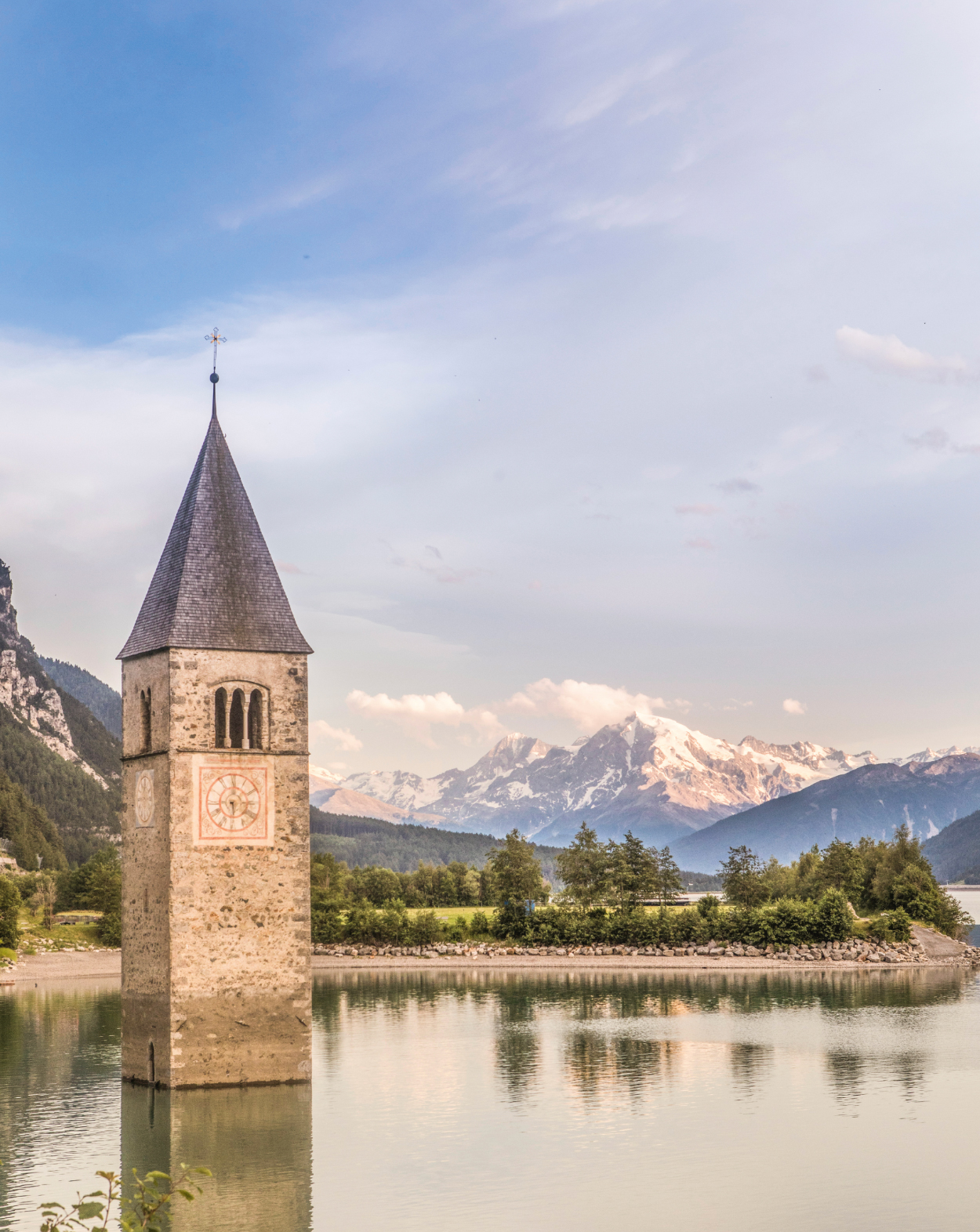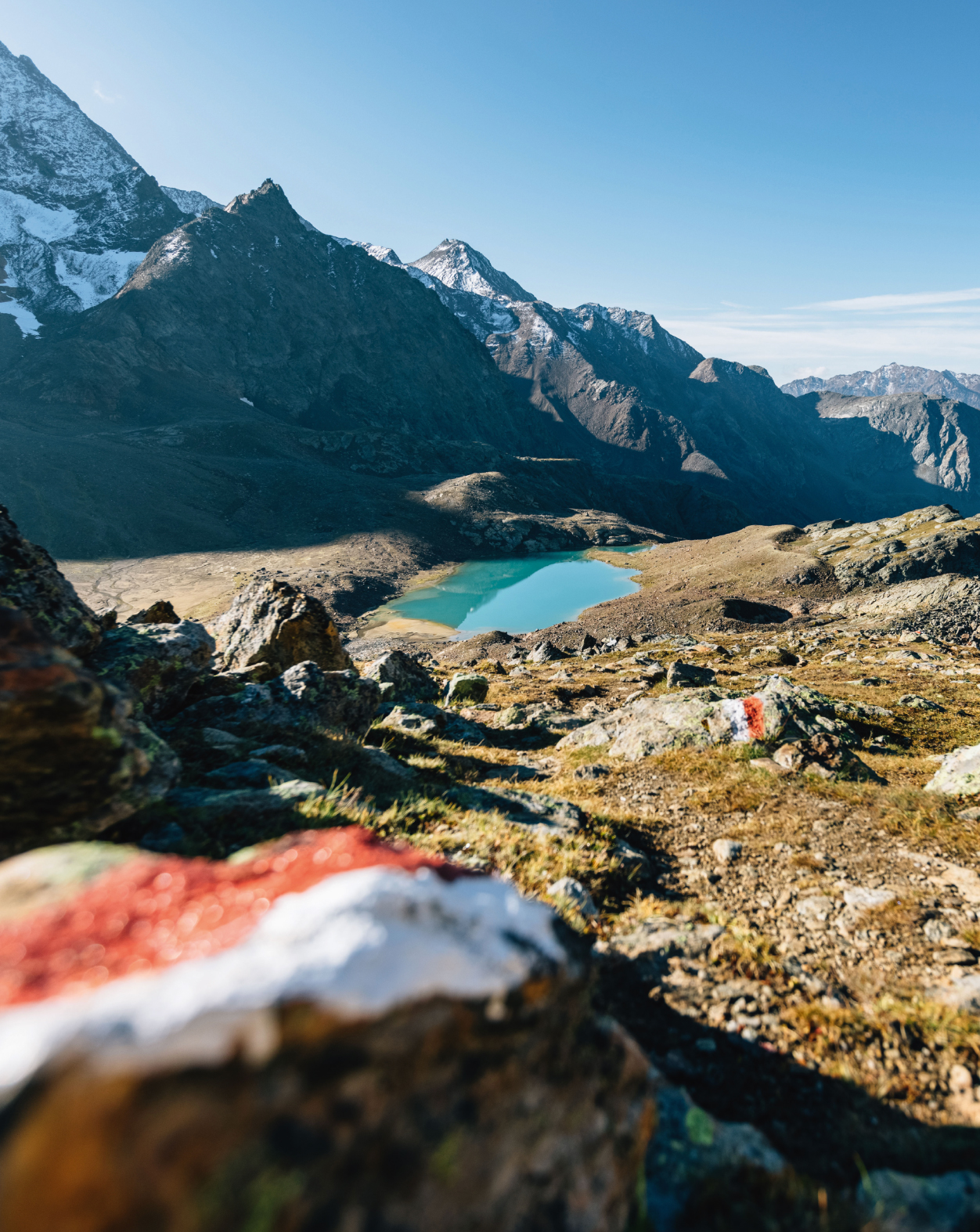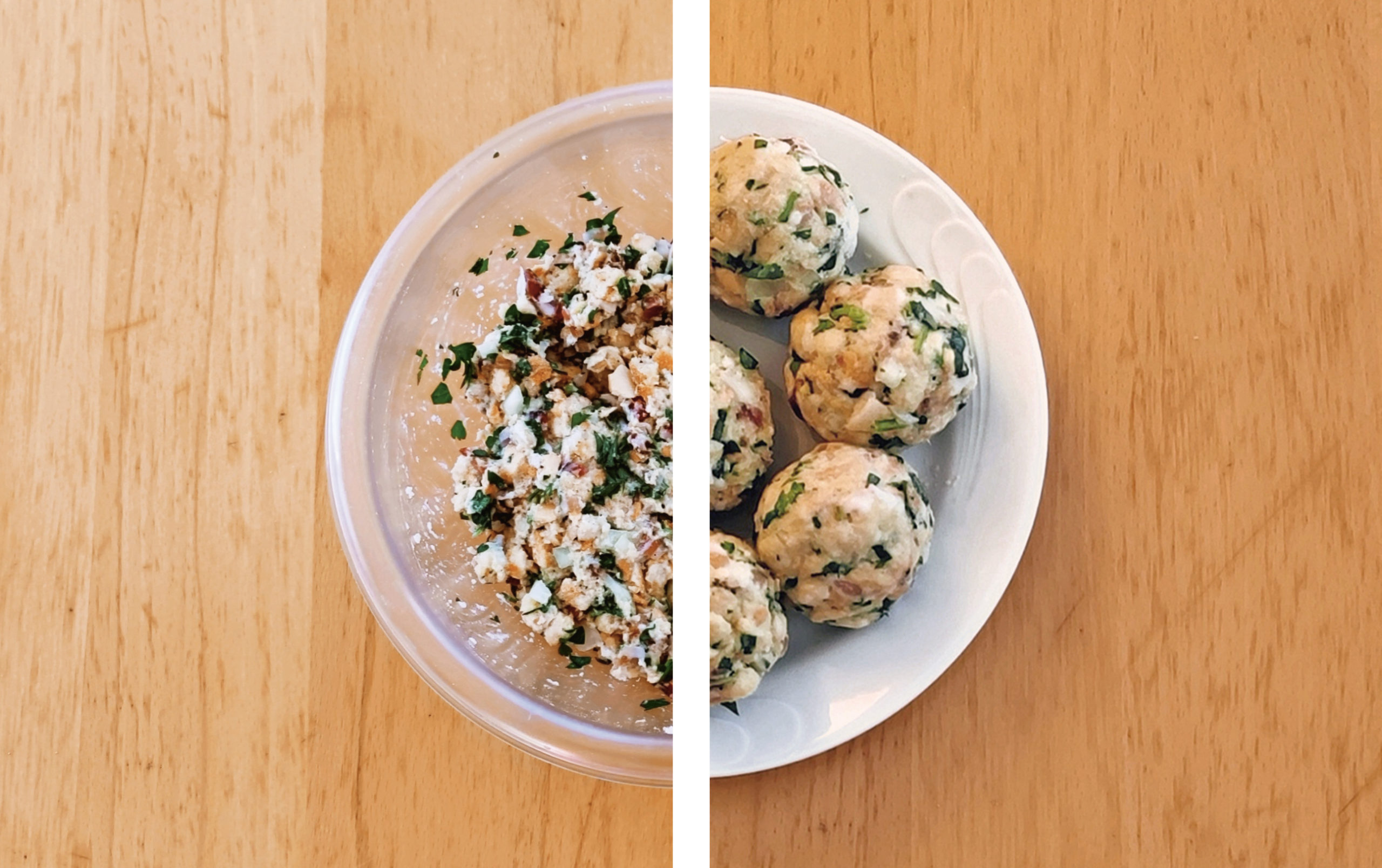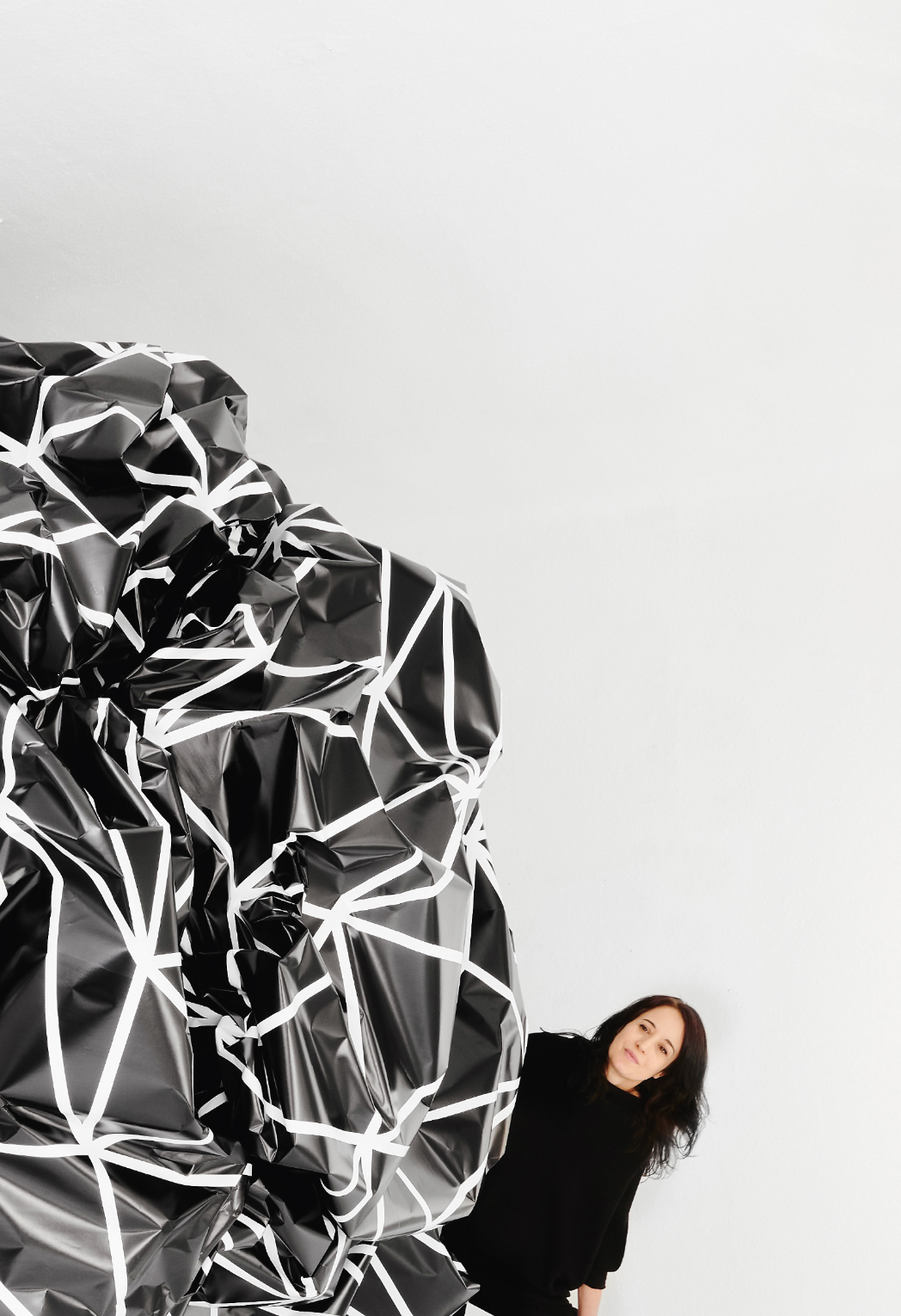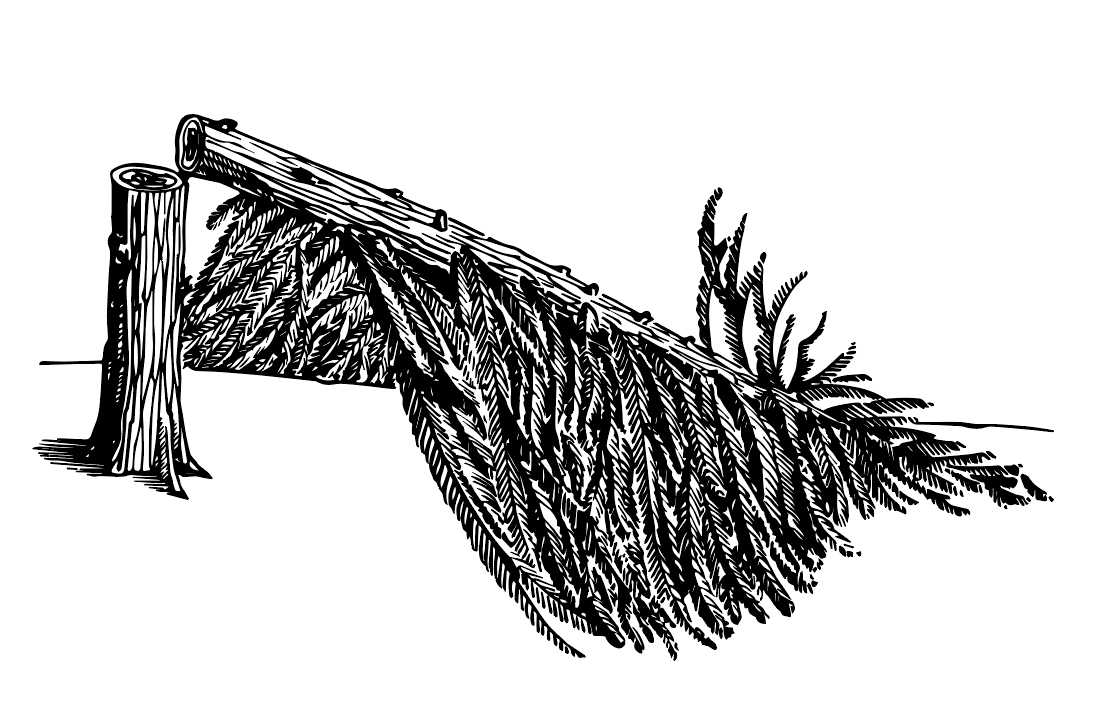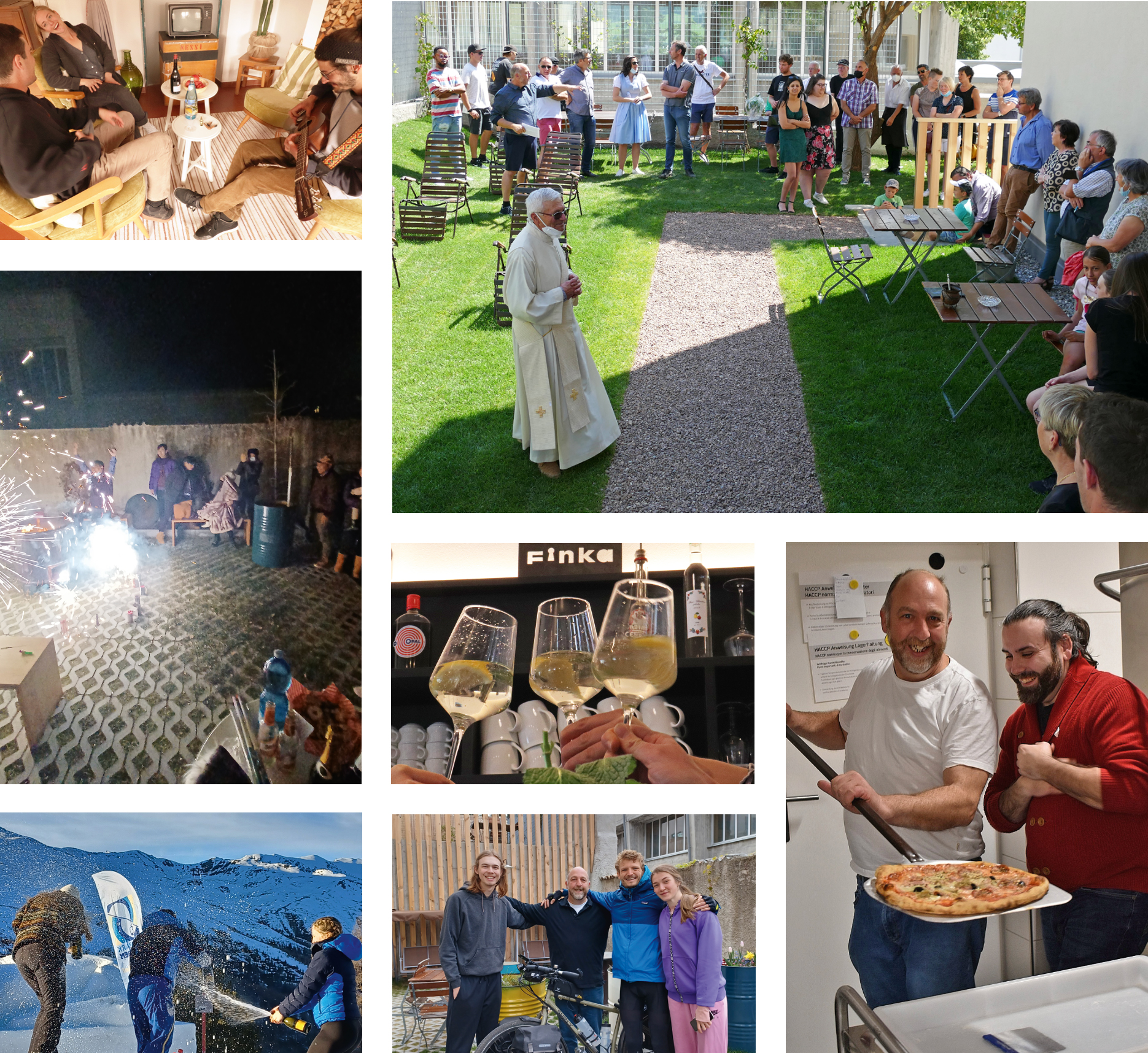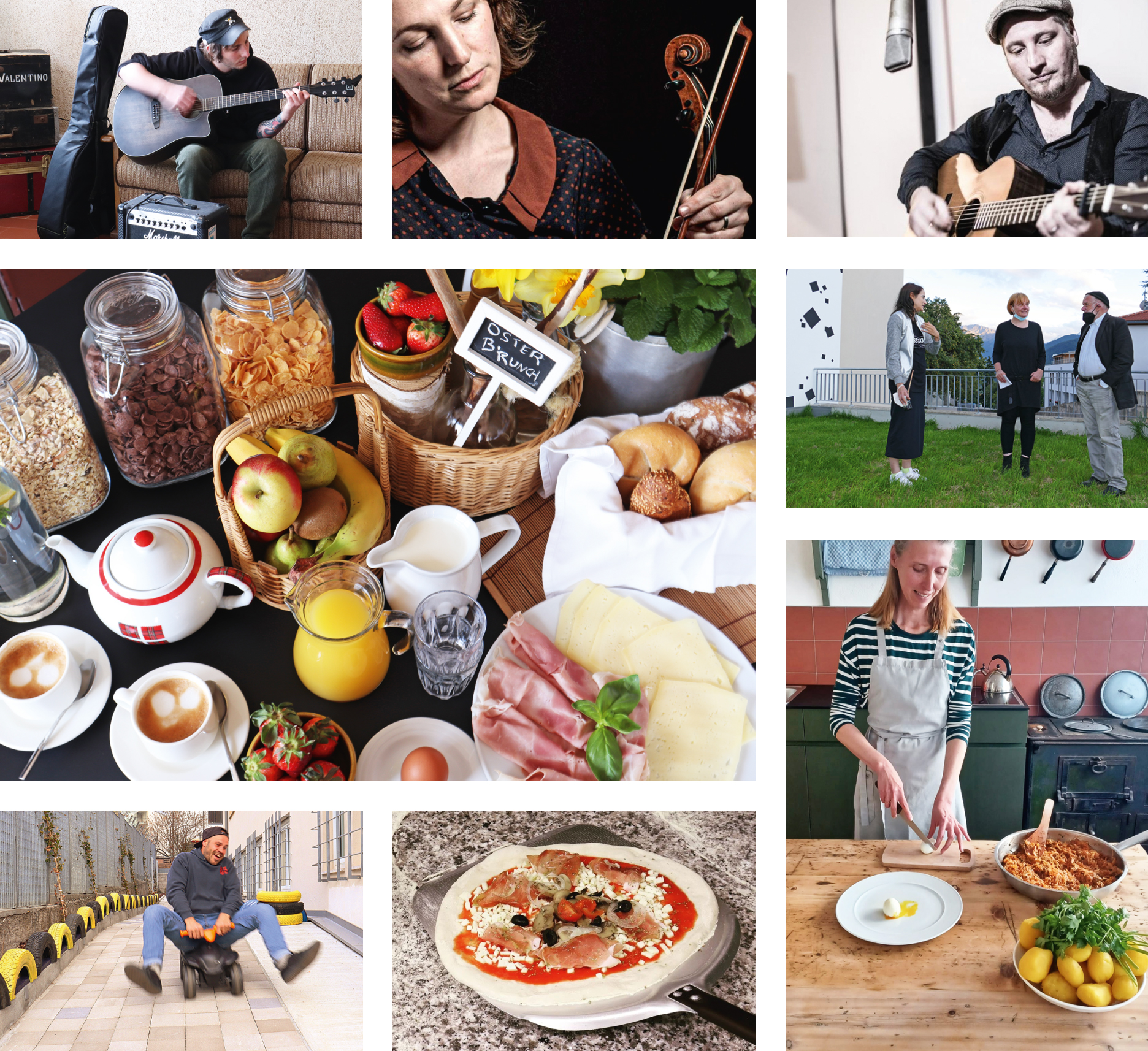Vacation in the neighborhood
Come as guests, leave as friends (and reluctantly).
Neighborhood does not only mean the vicinity of the village,
but also many cultural and sporting attractions…
(p. 7+)
Backyard holiday
From border patrol headquarters to backyard paradise!
Not only since its conversion into a hostel has the FinKa beenconsidered a
sociable place -All exclusive backgrounds!
(p. 4)
Page 1
Venostan hospitality is growing here
In Malles in the Venosta Valley there has been a barracks of the financial police since the end of the 1960s. Although in the middle of the village, it was more or less closed off during its time of use and has been vacant since 2005. But now the gates have been thrown wide open and it’s been transformed into a social, welcoming place: the FinKa Hostel, the first of its kind in South Tyrol. Turning a barracks into a cosmopolitan guesthouse is no easy feat – in this special issue we try to find out how it was done, what makes the hostel so unique and why it is, by the way, a prime example of sustainability, with facts and information, spotlights from the past and present and, of course, the usual Finanzer Times quality journalism.
Page 2
Future-proof metamorphosis
Sustainability is undoubtedly the buzzword of the 21st century, but unfortunately it is often just marketing (see p. 17). Fortunately, there are still some that see it differently; not for the sake of good reputation, cost savings or the like. but simply because it makes sense and feels right. The most recent example is the FinKa Hostel in Malles. The careful renovation and extension of the old barracks did not stem from a dislike of modern building styles, but simply from the awareness that the grey energy of the historic walls could not be compensated for by any new building, no matter how wonderful. The fact that the project was designed by Arch. Jürgen Wallnöfer, a luminary of gentle renovation, is a plus point; that he and almost all the craftsmen and companies involved in the building project come from the village (or at least the valley) is a matter of principle. Our heartfelt thanks go out to them!
Page 2
Pleasantly local
The concept does not end with the building. Even the refreshments for guests are made with delivery routes often only fifty steps away on foot. Over 75% of the food is sourced daily from local farmers or shops, making it organic, regional and natural. Not to be considered an ‚organic farm to table hostel‘ or similar #hashtags, but simply just because. This has been practised for years in the VISO’s other facilities, so naturally also in the FinKa!
Page 2
Down to the last detail
If you think that‘s the end of it, no, because this spirit runs through the entire hostel. Everything that had to be bought new to comply with regulations was intensively tested for quality and long-term durability. Photovoltaics on the roof make the FinKa self-sufficient for half of its energy. In addition, upcycling rules the interior. Everywhere you can find used items that have been given new life for decorative or other purposes. There are classics, such as repainted Viennese coffee house furniture from the 60s, but also creative approaches such as coat hooks made from old books or flower arrangements in infusion stands, even a discarded church altar was made into a reception desk. And every day new ideas are added to make a stay in the FinKa a little more homely than it already is.
Page 2
Social
responsibility
Last but not least, it is also the human aspect that is cannot be neglected. This includes not only the legendary Venostan hospitality – because since its foundation in 2013, the „VInschger SOzialgenossenschaft“ has been pursuing social perspectives and creating jobs for socio-economically disadvantaged people. In the projects initiated by VISO, for example, people with and without disabilities work together with refugees; they support regional value creation in cooperation with employment centres and social departments and combine economic efficiency with solidarity – for a responsible and sustainable way of life. In this way, the FinKa also creates an important contribution to the realisation of an inclusive society, in addition to all kinds of unique moments for its guests.
Page 3
A SPIRIT IS
ROAMING MALLES
It‘s hard to be a hotelier. It always takes the best, most innovative concept to convince guests to take their hard-earned money to the place where the winter break was just used to polish up the star rating. The need for optimisation and the hunt for relevance become even greater adversaries than the direct competition two doors away.
At least, that‘s what one would think looking at the situation in various tourist areas. Fortunately, the Venosta Valley is still far away from such. The number of small hotels and the few large temples of luxury do not out-compete each other; the guest can always choose according to their taste. Almost. What was missing until now was a solution for travellers looking for an affordable base camp for their activities, without the social isolation of an Airbnb or, at the other extreme, the (subjective) oversupply of services of a more upscale establishment. In short: a hostel. Ideally with a perfect location for sports and culture.
The VISO‘s decision to launch the FinKa project was therefore right on target. But what makes us at the Finanzer Times particularly happy is the place where it was opened: The old FinanzKaserne. Outsiders may be suspicious of seeking hospitality in a barricaded, fenced-off building, but that‘s the point. The old Finanz was only locked and mysterious for those on the other side of the walls. Inside, there was homely warmth, camaraderie and pure lust for life.
The Fiamme Gialle, who, at least initially, felt unwillingly like strangers in their own country up in the far North, certainly knew how to fight their homesickness and create a cosy atmosphere. So, it‘s hardly surprising why there was a distinct plea for re-use instead of new construction. The spirit of community, laughter, eating, drinking, telling stories, still lives within the walls – and through the now wide-open door, not only can the world enter, but also this very spirit can come out freely!
Page 3
Page 4
Designed for comfort
The FinanzKaserne’s task as a homely place to live was established with the first turned sod. Since it was always meant to bring comfortable living to the company of Malles (previously housed in a dilapidated building in the village), it was built state-ofthe- art in 1968 by the Theiner family – owners of the famous Mohrenwirt in Burgusio since the 17th century – and rented out to the financial police.
Page 4
Souvenir from the first tenants
During the research for this special edition of the Finanzer Times, we were shocked to hear about a bomb during renovation work! But luckily no one wanted to harm the FinKa, because after a thorough examination by the carabinieri who arrived with lights and sirens, it was found to be a smoke grenade, and no bad guys had to be locked behind the cell door in the FinKa’s dining room!
Page 4
Dear diary,
I have arrived safely in the northern colonies! It is different from home here; every road is uphill in both directions and the wind blows the teeth from my face and the fear of God from my heart. But the people are very nice; they don’t speak our language (and theirs is just funny noises) but the food is delicious, and they like to drink and sing, what more could you want? And after a good glass or three, communication becomes easy!
Even in the barracks, we don’t lack anything (apart from Mamma’s culinary magic…), and when the Maresciallo isn’t rushing us up a very high peak, it’s a nice place to live. The building is not the prettiest, but cosy all the same; I think it could be turned into a nice hotel or inn if we weren’t there!
Giuseppe
Page 4
Through night
and fog
Nel periodo tra le due guerre e nel dopoguerra, nella valle prevaleva la povertà assoluta. Il contrabbando era spesso l’unica via di fuga. Tabacco, caffè, zucchero e molto altro venivano „importati ed esportati“, ad esempio fino a 4500 tonnellate di sigarette all’anno! Molto redditizio, ma purtroppo illegale. La Guardia di Finanza a Malles e i suoi avamposti avevano il compito di prevenire il contrabbando e di proteggere i confini. Un gioco tra gatto e topo in alta montagna. L’ex contrabbandiere Peter H. ricorda: „Lo sento arrivare e penso: ‚Oh [imprecazione], ora è così‘. Ma mi guarda brevemente e dice: ‘Metti giù lo zaino e fuori di qui’. Il contrabbando a volte era il nostro unico guadagno e loro lo sapevano“. Anche se c’era un’antipatia generale verso gli italiani e non correva buon sangue, finanzieri e contrabbandieri di solito si trattavano con rispetto
Page 5
Found in
Slingia
Not only in Malles stood financial barracks, and by no means all of them still exist today. The Venostan author Toni Bernhart provided the FinKa with a found object from the long since demolished barracks of Slingia, which is now duly exhibited in the FinKa Hostel. How it came about:
There was a financial police barracks in Slingia. As far as I remember, the barracks were always closed. The blinds were closed and no one was there. Sometimes, but only rarely, and when the weather was nice, someone was there. Sometimes there were women and children there too. I saw that when I went with Uncle Gebi on the tractor past the barracks in the summer to work the hay in the meadow. That was a long time ago. I was a child then.
Much later, when I was in Slingia, maybe twenty years ago, the barracks were demolished. The building was opened, windows and doors were already broken out. There was mud and dirt in front of the building. The ground was ploughed up by construction machinery. Somewhere in the mud were pages and writings. I don’t remember exactly what I saw. I try to remember and imagine what I might have seen. Notes, perhaps, on which train you could travel from Malles to Trapani or to Cefalù. Maybe photos too. Maybe of Carmelo’s fiancée, who might have been called Aminta. Maybe of skiing in good weather in the Slingian mountains. Or of evenings in the barracks or elsewhere. Probably with pasta, wine brought along in demijohns, probably a locker behind it. Maybe there were financial policemen in the photos who were on duty or just eating. Maybe it was someone’s birthday. Maybe someone was saying goodbye who had been transferred.
Perhaps there were also forms lying in the mud, pre-printed sheets on which one could note checkpoints and times or with which one could apply for leave, perhaps also sheets with which one could have travel permission between home and the stationing place or unforeseen expenses reimbursed. It was wet and cold on that late afternoon in Slingia maybe twenty years ago and it was almost dark. I grabbed a stack of paper that had been stepped in the mud and brought it in to dry. I remember that clearly. After a few days the paper was dry. I tidied it up and put it aside. I remember that too, even though it was a long time ago. But memories become fainter the more time passes. Sascha asks me if I still have the paper I found. I still have it, I say, but I don’t know where. I look for it and can’t find it. For weeks I look for it and can’t find it. Then suddenly the package falls into my hands. „Found in Slingia, December 2002, during the demolition of the barracks“ it says. That’s the pile of paper I found and put aside, and that’s what I wrote on it.
TONI BERNHART
born in 1971 in Merano, is a professor of literature at the University of Stuttgart, a playwright and director. Bernhart has written numerous plays, including the text for the Thiersee Passion Play in summer 2022.
Page 6
Excursions on ice and snow
Although the FinKa was the main base in Malles, very little could be done from there. Therefore, there were subordinate outposts: one in Vallelunga, one in Valle Roja, one on the Austrian border at Resia and the Swiss border at Tubre, and one on Piz Chavalatsch, a mountain of 2760 meters near the Swiss border area. In general, border controls on official traffic routes were not the main focus, but rather the rough paths in the high mountains. The finanzieri therefore had to be in top shape and deal intensively with how to move and survive in the high mountains; in their manual at the time, for example, a section on appropriate footwear already covered half a dozen pages, not to mention more complex matters such as avalanche safety or medical emergencies.
Page 6
Militarily
structured
A barracks full of mostly 19-22-year-old policemen far from home may sound a bit chaotic, but the Fiamme Gialle were a special unit and strictly organised. The Capitano’s subordinate was the Tenente (lieutenant) and under him the leader of each unit of 10 finanzieri, the respective Maresciallo. We let one of them look back a little, in the exclusive Finanzer Times interview…
Page 6
Before and after
Some spaces in the FinKa, even if renovated, have not moved much from their original place. The „Spaccio“ already existed back then (even if only as a small shop) and the second floor was already full of bedrooms. Some things have changed a lot, though: In today‘s entrance area stood a car repair shop, in place of today‘s rooftop suites with view on the Ortles there was an archive – whose tiles have found a new home in the foyer – and today‘s rainwater reservoir for watering the garden was actually an oil tank before. A stroll through the building reveals, again and again, details that hint at its previous use, and the transition from the Finanz- Kaserne to the FinKa was pretty seamless. Only the wooden attic was newly set on top of the building, almost like a crown.
Page 7
Valley of contrasts
The FinKa in Malles is the theme of this issue, so our travel tip naturally revolves around its little corner of the world: the Venosta Valley. Located in the heart of the Alps, at their exact centre even, the geographical Venosta Valley extends from the Resia pass to Tel, but the political one only to above Naturno. Since the first occupation by the Romans, it has had a turbulent history and great battles have been fought over this western part of South Tyrol. Even apart from the political differences, it has undergone many transformations from a large forest area to the granary of Tyrol to an apple paradise and tourism secret tip.
The Venosta Valley is unique in many ways. Thanks to the surrounding mountain ranges of 3,000 metres, it lies in its own climate zone with 300 days of sunshine a year and weather conditions that only occur again in northern Italy below Lake Garda. This not only ensures steppe-like flora and fauna on one side of the valley and alpine mixed forest on the other (called Sonnenberg and Nördersberg, respectively), but also remarkably little precipitation. This used to be solved by an ingenious irrigation system, the Waale, which are still an interesting destination for excursions today. Unusual for the Southern Alps are also the number of side valleys (14, 10 of which inhabited) and the great differences in altitude (up to 2500hm over a distance of 5km). Truly a fascinating valley!
Page 7
Easy riding
One of the best ways to explore the many beautiful places of Vinschgau Valley is by bike, because a big section of the famous Via Claudia Augusta cycling path leads straight through it, from Resia to Merano, passing and crossing fragrant orchards, lush pastures and fabulous cultural sights. Of course, bikes can be rented at (almost) every train station on the way and returned at the others, too!
Page 7
Non-stop action
The Venosta Valley does not only appeal to those seeking pleasure or peace. It also has a knack for adrenaline and offers many opportunities for single-trail flow, downhill biking, climbing and mountaineering, canyoning and rafting, paragliding and all kinds of other exhilarating activities! Most of them come with local guides, so even beginners can enjoy extreme sports.
Page 8
Shhhh! Our insider tips
Away from the (quite rightly so) famous sides of the Vinschgau Valley, there is plenty to see that not even all the locals know about. A spontaneous selection (more tips on request, of course!):
Bunker 23
A camper in the bunker wall, a railing in the shape of the sound frequency of Lennon‘s „Give Peace A Chance“ – the re-used bunker of the late, gone too early Benny von Spinn is a unicum that is now being transformed piece by piece into a symbiosis of art and nature by his companion Othmar Prenner.
Working vacation
Digital nomads who combine travel and work, or workaholics who can never quite switch off, the Coworking Mals in the old weaving mill „Salutt“ offers a quiet space, lightning-fast internet and networking opportunities for all. The mechanical looms on display also create a unique atmosphere to work in.
A drink with Sascha
Guests usually come to the Back Office only rarely and with worries, and the „real“ bar in the Spaccio is beyond reproach. Nevertheless, the boss‘s small, exquisite whisky corner knows how to delight – also because hour-long conversations about music, philosophy and everything else are gladly served there, too.
Page 9
Living traditions
Despite their poverty, the inhabitants of the Venosta Valley have always been a fun-loving people who celebrate every festival that comes along. The calendar of events in Malles and the surrounding area is packed; from religious festivals to events such as the Medieval Games in Sluderno to the two annual markets (Georgimarkt 23.04. and Gollimarkt 16.10.), there is always something to celebrate with food, drink and music.
Page 9
On the smugglers‘ path
Many of the smugglers‘ routes (although now safely secured) can still be hiked today, e.g., through the alarmingly narrow Uina gorge into Switzerland. For those who want to combine the historical smuggler‘s feeling with sport, the annual smuggler’s race to the Sesvenna Hut is recommended: packed full with the food that is needed up there, the aim is to conquer the steep ascent as quickly as possible.
Page 9
Did you know?
Although the “capital” of Val Venosta is Silandro, there is also a city in the valley – namely Glorenza, the smallest in Italy with only 900 inhabitants! In the Middle Ages, this neighbouring community not far of Malles was granted city status and still has it today. To make up for it, Malles has five towers that are visible from afar – but since the completion of the Finka lift shaft with its Esther Stocker motif, there are now actually six…
Page 9
The steeple in the lake
Speaking of towers: a short drive away waits another, the official landmark of the Venosta valley. The church tower of Alt-Graun rises lonely out of Lake Resia, the only evidence of the expulsion of the inhabitants and flooding of the village. Despite its tragic history, the steeple in the lake is (rightfully) a beloved photo motif and, thanks to the notorious Venostan wind, also a kitesurfing hotspot.
Page 9
Natural spectacle Deluxe
In the Venosta Valley there are a multitude of unique natural spectacles. One example: At the far end of the Mazia valley, near the Saldura peak, which is little developed for tourism, lie the lonely Saldura lakes – a place of untold power with an almost mystical tranquillity and a magical play of colours. The upper of the two lakes is deep dark blue, while the lower one is bathed in radiant turquoise. Fascinating!
Page 12
Many cooks
confuse
the broth
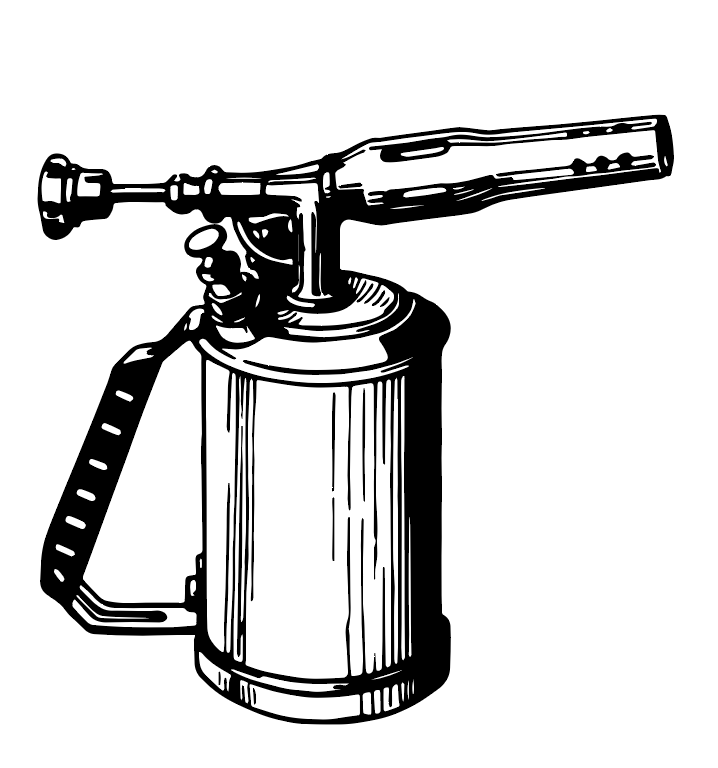
Dear Reader, it’s the first time in my career, but I can’t give any stars today, because there was nothing to rate!
I was asked to review the FinKa Hostel for its gastronomic qualities for this special edition of the Finanzer Times. The establishment is tasteful, the staff courteous, but that is where my praise ends. Hungry, I went to the local „Al Fornetto“ to be surprised. An acquaintance had whispered to me that everyone was allowed to use the kitchen, as in, that every evening you would see different cooks showing off their skills in a small circle, so you never know what you’re going to get. A bit too postmodern for me, but one is open to new things.
But there was no one to be seen! All the equipment was there, but no one to operate it! My senses were already dwindling from malnutrition when I saw a group of young people in sporty outfits enter and start cooking, laughing happily. I couldn’t make out who was the chef and sous-chef and who was just a kitchen assistant in the hustle and bustle, because they shared all the tasks.
Finally, they had conjured up what looked like nectar and ambrosia to me in my culinary neglect, a pasta dish – which they sat down with and ate themselves!!!!
0/5 stars!
Well, maybe 1 star because they at least brought me a glass of red wine and said they would have loved to give me something if I had made my presence known, but I am still outraged and offended!
Page 12
Pizza that touches the heart
I think my dear colleague misunderstood me when I tried to explain the FinKa’s open kitchen to her. The language barrier maybe, and she’s not the youngest anymore…. Well, it doesn’t matter, because there are more important things to talk about!
That is: Pizza! The most important topic of all. Those who know my columns here in the culinary section of the Finanzer Times should know how much I adore these delicious flat goods, and everyone else will know soon enough. So, it was inevitable that sooner or later I too would approach this former barracks in Malles in the Venosta Valley, on the one hand to make up for Doris‘ bad review a little, and on the other hand to taste the pizza there myself.
The food at the FinKa is very rich and tasty, from breakfast to the optional bag lunches to the changing daily specials and small snacks, all highly recommended and delicious, 5/5 stars, it fits! So, with that aside: to the pizza! And what a pizza you get there. Crispy yet wonderfully soft, with natural and regional ingredients, baked to perfection and with a smell that makes me float blissfully along its path to the table like in a cartoon on TV.
In general, pizza baking is a real affair of the heart at the FinKa. If you happen to visit when they have a new batch of fresh dough, the host speaks enthusiastically about it, as if it were a child’s first steps. Watching the pizza maker’s careful and skilful work, I fall into a Zen-like state of concentrated calm myself. That turns into exultant joy as soon as the steaming hot delicacy is in front of me.
I can proudly say that I have tasted hundreds of pizzas so far, and this one is without a doubt right up there with the best. I have already asked if I can have one with all my meals from morning to night, but I have yet to receive an answer.
Page 13
Original South Tyrolean
bacon “Knödel” (dumplings)
4 PERSONS
Probably the most famous South Tyrolean dish. There are basically as many dumpling variations as there are cooks – our Finanzer Times readers can find out the classic bacon dumpling recipe here!
Ingredients:
300g „Knödel bread“ (old white bread, diced)
1 handful of parsley
4 free range eggs
1 onion
250ml whole milk
1 tbsp flour
150g bacon or pancetta
Salt and pepper to taste
Preparation:
Chop the onion, bacon and parsley. Mix the dumpling bread and milk in a bowl. Knead with the remaining ingredients to form a coarse mixture. It should be moist but not wet (stretch with breadcrumbs, no more flour). Salt, pepper and leave to stand in the fridge for 20min.
Shape 8 balls with wet hands. Not rolling too tightly/too loosely is a time-honoured art; beginners are advised to remember childhood snowball fights. Don’t throw dumplings around then, of course, but let them sit unrefrigerated for 10-15min.
Meanwhile, bring salted water to a boil. The decision: How to serve? On land (with salad) dumplings are steamed, on water (with soup) simmered. Either way after 20min. fork check – no dough should stick – and serve either with green salad or in beef broth. Sprinkle with chopped chives if desired and enjoy!
Page 14
She who plays
The FinKa’s lift shaft, striking signpost and artistic landmark with an international reputation – thanks to Esther Stocker. A portrait.
It’s always nice to see well-known personalities going back to their roots. This is what happened with the design of the FinKa’s „lighthouse“. Although its creator is active in the wide world and at home in Vienna, she her heart has always remained in Malles. So, Esther Stocker did not hesitate for a second when she was approached to design this prominent area of the FinKa building. According to her design, the black-and-white motif of seemingly randomly arranged yet harmonious cuboids was lovingly hand-painted by the experienced painters of the Steck company and immortalised on the 16-metre-high façade. The FinKa in Mals thus joins the long list of museums, galleries, corporate and residential buildings that Esther Stocker has decorated with her unique style all over the world – even the Italian embassy in Vienna is adorned with her geometric lines.
Esther Stocker was born in 1974 in Silandro and studied at the Academy of Fine Arts in Vienna, at the Brera in Milan and in Pasadena and Chicago in the USA. It is therefore not surprising that she has been internationally successful as an artist since 2001. This is evidenced not only by over 200 solo and group exhibitions all over the world or her inclusion in various renowned collections, but also by awards and honours such as the Prix Aurelie Nemours, the South Tyrolean Prize for Art in Building, the BKA’s Förderpreis für Bildende Kunst or, for the local reference mentioned at the beginning, the Paul Flora Prize.
But that’s not all: Esther Stocker also lets her creative energies flow in painting, photo and video projects and fashion (e.g., Paris Fashion Week 2020). It would go far beyond the scope of this article to tell Finanzer Times readers about the entire creative spectrum of this exceptional artist from Malles – the only thing that will help is a devotional contemplation of the artwork on site, and a long visit to estherstocker.net!
Page 15
A race of wits
Despite the many well-preserved documents from the active time of the FinanzKaserne, there is no better insight into the daily life of the financial police than the memories of one of them. That is why we exclusively caught up with Bruno Pileggi, a former Maresciallo in Malles for 20 years, and asked him a few questions:
Finanzer Times: How should one imagine the daily life in the barracks?
Bruno Pileggi: The main job was border security, both along the main routes, but especially in difficult terrain in the mountains. In addition to containing the smuggling, all border markers had to be checked every week to make sure that the Austrians or Swiss had not moved them in their favour. However, this never happened in all my time in service.
‚At home‘ in the barracks, life was rather pleasant, as it was built for that very purpose. There was a TV room, a pool table, everyone took weekly turns cooking for the others, there was really a close-knit community.
FT: How was the relationship with the residents of Malles?
BP: From indifferent to contemptuous. Italians were not welcome in the Venosta Valley at that time and were regarded as occupiers. However, there were few open hostilities and no violent confrontations. What I must mention here is the relationship with the smugglers. For many, it was the only way to survive, and most of us did not want their and their families fell into abject poverty. Sure, there were financial police who never showed benevolence and smugglers who did their best to fight them, but in general there was mutual respect. It was more of a challenge: since both we and the smugglers knew all the routes, it was a matter of estimating when the other would take which route, a race of wits, so to speak.
FT: Where did the Fiamme Gialle come from? From the Venostan point of view, ‚Italians‘ are all from Trento to Palermo.
BP: Mostly from the South, there were no other great prospects there, you either joined the mafia or became a policeman. Thanks to the different origins of the finanzieri, there was also a cultural exchange, we were all one big family, even with different dialects and culture. And through our identity as part of the Fiamme Gialle; it was a special unit at the time and much more militarily structured than today. The admission criteria were strict, you had to be in top shape physically and mentally and your ancestors had to have never committed a crime until the seventh generation (today that’s different). So, in short, we were the best of the best in Italy; I personally, for example, was the first from my village to be admitted.
FT: Did any other of the finanzieri besides yourself remain in Malles when the barracks were decommissioned and moved to Silandro?
BP: A total of 23 of us married a woman from the village and started a family. Many are now the third generation to live here!
Page 16
mysterious keyhole…
At the beginning of 2021, mysterious keyhole-shaped stickers appeared everywhere in the Venosta Valley, puzzling locals and guests alike. Art installation? Advertising for a locksmith? Political statement? Neither, but a teaser for the opening of the FinKa, which was soon followed by a display board and several posters and flyers, also with a keyhole motif.
A few months earlier. In line with the plan to leave all tasks relating to the FinKa in the valley, the VISO turned to BASIS Venosta, a structure for transdisciplinary promotion and education in business, culture and social affairs based in the former Druso barracks in Silandro. With Lukas Tappeiner (project management), Katrin Gruber and Laurin Kofler (graphics & design) as well as Ben Ratschiller (content & social media), a competent team was soon put together that, in cooperation with Sascha Plangger & Co, was to develop a concept for the – at that time still nameless – FinKa. This name was finally able to prevail over about 20 others (which were also very good).
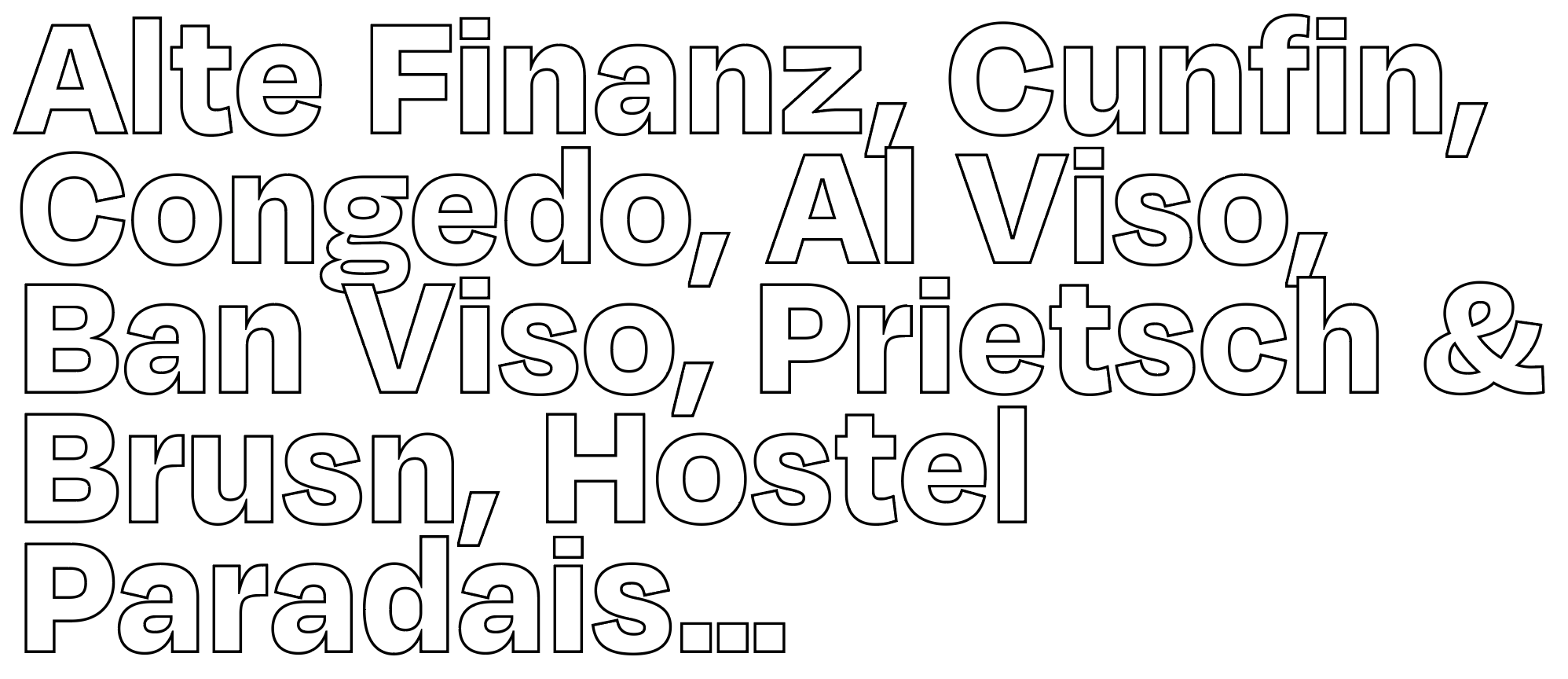
It was also the „unlocking“ of the barracks, which had been locked off to the public for decades, that brought about the prominent use of the keyhole motif. The homely, hidden seclusion in the middle of the lively village was perfectly summed up by the slogans „Urlaub im Hinterhof“, „vacanza in vicinanza“ and „Bed’n’Backyard“. A special stroke of luck was, of course, the fact that the finanzieri left behind many records and manuals whose details, pictures and quirky attributes are reflected everywhere today, in the house as well as in printed matter or online. Thus, not only the building was re-used, but also these contemporary testimonies of the previous owners.
Of course, the conversion itself did not go ahead without industrious creative input. The unique esternal vestibule of the FinKa’s entrance and many details of the upcycled interior originate from Laurin’s wealth of ideas, while Katrin decisively influenced the colour concept and the design of the guidance system and, together with Ben, the naming of the FinKa’s rooms.
Since the grandiose opening to much acclaim from guests and the media, the VISO has been steadily working to breathe its own unique touch into the hostel and hundreds of enthusiastic guests can now attest to the fact that the FinKa project has become a complete success. The Finanzer Times will continue to monitor this unique hostel in the middle of Malles and provide our readers with all the red-hot news!
KATRIN GRUBER
is a freelance graphic designer who, in addition to FinKa and BASIS in Schlanders, has also given free rein to her design and artistic talents in many other projects, e.g., avimundus, Vinschger Ölmühle and Eau&Gaz.s
LAURIN KOFLER
is the man behind the renowned Studio Formbar and an expert in communication design and experience architecture. His work includes various exhibition concepts as well as collaborations with the Kurhaus Merano, the Salzburger Stier 2019 or the Grandhôtel Orchestra Toblach.
Page 17
The laughing little tree
„We cannot change the wind, but we can set the sails differently“ is a wise saying often wrongly attributed to Aristotle. But far too often, the sail is just a decorative flag, spinning merrily as the ship heads for the iceberg.
You may forgive the Titanic allusion (and the theme song stuck in your head, you’re welcome), but that’s the way it is. Mother Nature’s patience has run out, the world we live in has not been able to completely eradicate the damage done to it in time since the mid-1970s, we are doomed!
No, we are not. Even if the sole shifting of responsibility for environmental protection to the end consumer is a proven, targeted propaganda tactic of the oil and heavy industry, which still cause almost 70% of CO2 – and other environmental pollution – it does not hurt to think a little about the future. Avoiding single-use plastic, short delivery routes, saving energy or recycling alone will not save the world, but at least it will not make it worse. Awareness of this is also growing in many companies and businesses – one would think.
Because with the emergence of sustainability as the buzzword of the hour, a new approach has also developed: The „alleged“ environmental protection, the greenwashing, the highlighting of marginal positive actions and the concealment of, far greater, negative ones. A laughing tree with a thumbs-up on the logo, a well-manipulated statistic in the advertising concept and the hippies are satisfied and stop boycotting!
Well, most of the people I have in mind with these lines are not 100% lying (because illegal), but only exaggerating. Tourism in particular is guilty of this. Yes, the tour operator in the Caribbean only offers sightseeing in an electric car – but the plane to there still uses hundreds of litres of fossil fuel. Yes, at the five-star hotel in the world-famous metropolis, soap comes from a dispenser and guests are asked not to throw towels into the laundry immediately – the three-storey spa area still needs as much electricity and energy as a week of the Summer Olympics. Yes, recruiting #greenfluencers and creating awareness is a step in the right direction, but gagging them with prescribed texts and obscene hush money is not the fine English way. And the like.
I often have to deal with it professionally and avoid supporting it out of moral duty. If you blatantly waste resources, then you should stand by it and take the criticism. But looking the other way doesn’t make it any better, it only soothes my conscience. That’s why I’m happy when I meet businesses or projects that do things differently, that stand behind them out of conviction. Not because it is cool, but because it is simply right.
That’s why I was thrilled to be able to participate in the creation of the FinKa. As a coworker and member of BASIS Venosta in the ex-Druso barracks in Silandro, I have a soft spot for such things. But the more I talked to the FinKa team, the wider my smile became. Jobs for the socially disadvantaged. All manual and intellectual work done by people from the valley. Almost complete preservation of the building materials. Food from the shop around the corner. Upcycling galore. Solar power producing considerable kW. And all of this as self-evident as getting dressed in the morning, some details I even learned privately only in passing, they were already so anchored in the sustainable zeitgeist of the VISO that it no longer seemed worth mentioning. Something like this warms my heart, which has been disillusioned by far too many empty advertising promises.
The world needs more outreach like this, not only in tourism, but especially there. And more such fantastic pizza, but that’s just by the by.
Ben Ratschiller a. k. a. Zeilenheld is a writer, essayist, writing coach and copywriter. In this last capacity, he has designed FinKa’s corporate language and texts for the web, print and social media – but today he gets to rant here in private.
Page 18/19
FINKA
UP CLOSE!
At the opening, Deacon Luigi Piergentili stole the show from all fashionistas in a flowing white dream.
At the FinKa, there is always something to celebrate (and if there isn’t, you’ll find a reason), and every time it is an unparalleled moment of joy.
Thirst is worse than homesickness! Also known as Venostan champagne, the FinKa Hugo makes for a summerly refreshment all year round.
The pizza oven at the FinKa is magic and the pizza makers almost fight for their turn to
show off their art.
A secret relationship? During the concerts of Dominik Plangger and Claudia Fenzl, the two got very close… Let’s wait and see!
In the morning you should eat like a king. That’s no problem with the FinKa breakfast, and thanks to the
bag lunches, not out and about either!
Anti-Lowcarb: The FinKa’s pizza makes us happily ignore all dietary advice – that’s why we don’t have any
in this issue!
Esther Stocker inspects her work on the FinKa’s lift shaft lighthouse – and seems visibly thrilled.
Maybe she’ll give us an autograph?

